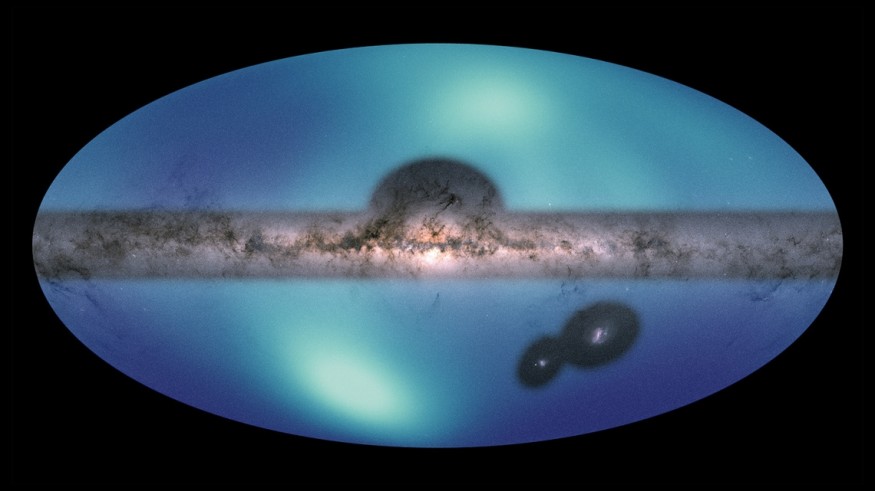Astronomers have unveiled a new all-sky map of our galaxy's outermost region using data gathered from the telescopes of NASA and the European Space Agency (ESA). Identified as the galactic halo, the region is located outside the central disk of the Milky Way and is home to a small number of stars.
While this halo may be apparently empty, the area is expected to carry a massive amount of dark matter, which is an invisible and mysterious substance that is said to constitute the majority of all the mass in the universe.
Data Gathered From NASA, ESA Missions
This new map came from gathered data from NASA's Near Earth Object Wide Field Infrared Survey Explorer (NEOWISE) that operated from 2009 to 2013, and ESA's Gaia mission. The study entitled "All-sky dynamical response of the Galactic halo to the Large Magellanic Cloud," was led by astronomers from the Center of Astrophysics of the Smithsonian Astrophysical Observatory and Harvard College Observatory. It used data collected by the spacecraft from 2008 to 2019.
The map shows how a small galaxy named the Large Magellan Cloud (LMC) traveled through the Milky Way's galactic halo, with its gravity creating a wake in the surrounding stars, the University of Arizona said in an article.
The LMC is situated around 180,000 light-years from Earth, and less than one-fourth of the Milky Way. While the inner portions of the halo have been accurately mapped, this is the first map to offer a similar picture of the halo's outer regions, where the wake is seen, about 200,000 light-years to 320,000 light-years from the galactic center. Previous research had indicated the wake's presence, but this all-sky map confirms its existence and provides a detailed view of its size, location, and shape.

Rare Opportunity to Study Dark Matter
The halo's disturbance also offers astronomers a chance to study something they could not analyze directly: Dark matter, as NASA emphasized in an article.
While dark matter does not reflect, absorb, or emit light, its gravitational influence has been studied across the universe. It is believed to create scaffolding where galaxies are built, and without it, galaxies would scatter as they spin. Dark matter is projected to be five times more common in the universe than all matter that interacts and emits light, from planets to gas clouds and stars.
Although there are various theories on the nature of dark matter, all of them show that it should be present in the Milky Way's halo. As such, as the LMC travels through the halo, it should also leave a wake in the dark matter.
The wake seen in the new star map is also considered the outline of the dark matter wake, The stars are similar to leaves on the halo's surface of the halo. Their position would shift with the dark matter.
LMC-Dark Metter Interaction: Massive Implications on Our Galaxy
Interaction between the LMC and the dark matter has massive implications on our galaxy. As the LMC orbits the Milky Way, the gravity of the dark matter slows down the LMC. This will cause dwarf galaxies' orbits to become smaller until the galaxy collides with the Milky Way in two billion years. These galaxy mergers would be an important driver for the growth of immense galaxies in the universe. The Milky Way, astronomers believe, merged with a small galaxy 10 billion years ago.
The new map, the study authors note, may offer a test for various theories on the nature of dark matter, such as its constituting particles, like regular matter, and the particles' properties. They compare it with the wake behind a boat, wherein such would different if it sailed through water or honey. Properties of the wake, they said, are determined by the applied dark matter theory.
The astronomers mapped out positions of 1,300 stars in the halo. The difficulty arose in the attempt to gauge the exact distance from Earth to a large area of those stars. Figuring out if a star is faint and nearby or bright and distant is close to impossible, they said. Data from the ESA's Gaia mission, which pinpoints the location of many stars but could not measure distances to the stars in the Milky Way's outer regions.
Once the stars in the halo are identified, the astronomers searched for stars that have a particular light "signature" spotted by NEOWISE. Identifying the basic properties of the selected stars allowed the astronomers to know the stars' distance from Earth and create the new map. This map charts an area starting 200,000 light-years from the center of the Milky Way, or around where the LMC wake was forecasted to start and extends to around 125,000 light-years beyond it.
The new map, according to NASA, likewise offers astronomers a rare chance to test dark matter properties in our galaxy. Astronomers used cold dark matter, a popular dark matter theory, that suits the star map very well. They would then run simulations that utilize various dark matter theories to determine which of them best matches the wake seen in the stars.
RELATED ARTICLE : Experts Found Vast 'Halo' of Dark Matter Around Dwarf Galaxy
Check out more news and information on the Milky Way on Science Times
© 2025 ScienceTimes.com All rights reserved. Do not reproduce without permission. The window to the world of Science Times.











